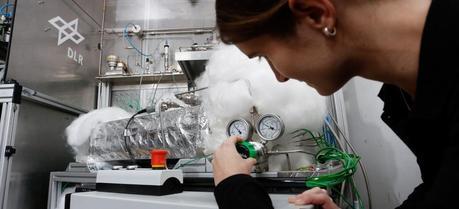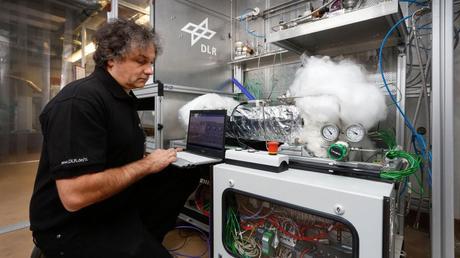 An innovative hydrogen tank would not explode even if it leaks. (Credit: German Aerospace Center)
An innovative hydrogen tank would not explode even if it leaks. (Credit: German Aerospace Center)The German Aerospace Center (DLR), together with its partners in the SSH2S European research project, has developed an advanced hydrogen tank for vehicles. The new hydrogen tank is suitable for holding hydrogen in a compact space under moderate pressure and at ambient temperature.
Coupled to a fuel cell, this tank was fitted into a vehicle for the first time as an integrated system and is able to supply electrical energy for air conditioning, auxiliary heating and lighting.
SEE ALSO: Air Liquide to Install 4 Hydrogen Fueling Stations in Denmark

The integrated system: hydrogen tank and fuel cell. (Credit: German Aerospace Center)
The modular hydrogen tank consists of individual tubes placed side by side. They are filled with two different solids—black metallic alloys, whose consistency is comparable to that of flour. These storage materials absorb the gaseous hydrogen like a sponge to which it is then bound. This property enables storage of the gas in a small volume under a pressure of 70 bar and normal outside temperature, which is substantially better than a conventional tank that requires the hydrogen to be kept under a pressure of 700 bar.
Inga Bürger, Project Manager at the DLR Institute of Engineering Thermodynamics mentions another advantage: “The use of solid materials in the tank means that hydrogen can be stored very safely; even if there is a leak, the strong bond between the gas and the storage materials ensures that hydrogen escapes at such a slow rate that there is no risk of explosion.” The DLR researchers have succeeded in developing an innovative, combined tank equipped with new materials that exhibit a far greater storage capacity.
As part of the project, the researchers connected the tank with solid materials up to a high-temperature fuel cell for the first time, delivering electricity and the heat required to release the hydrogen from the storage materials. The entire system was fitted to an Iveco Daily van as an Auxiliary Power Unit (APU). Equipped with an additional fueling port, the vehicle can be refueled at a hydrogen filling station. The tank has a volume of 10 liters (2.64 gal) and offers a storage capacity of 1400 liters (369.84 gal) of hydrogen, sufficient to provide the van’s APU with one kilowatt of electrical energy for two hours.
The University of Turin (UNITO, Italy) coordinated the EU research project SSH2S. EU-wide, it involved seven research centres and companies: DLR, Karlsruhe Institute of Technology (KIT), the Institute for Energy Technology (IFE, Norway), Tecnodelta s.r.l. (Italy), Serenergy A/S (Denmark), Fiat Research Centre (Italy) and Joint Research Centre of European Commission (JRC, Netherlands). KIT, IFE, JRC and UNITO lead the development of the storage materials. DLR cooperated with its partners, Technodelta and the Fiat Research Centre, to create the combined tank and the fuel cell coupling, and also their integration within the vehicle. The European Union provided €1.6 million ($2.18 million) in funding.

